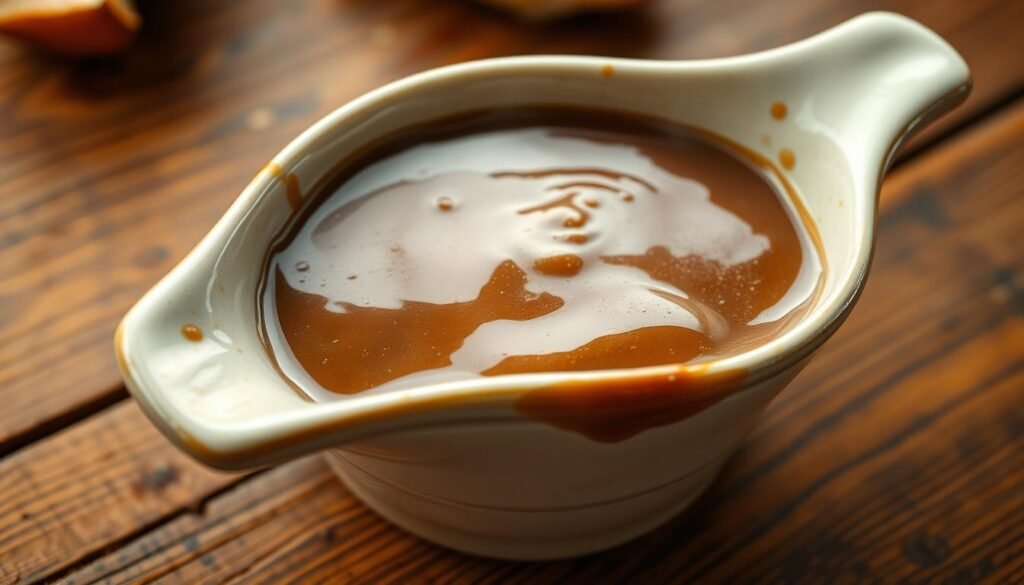Imagine making your meals better with a rich, savory gravy in just a few minutes. Homemade brown gravy can turn simple dishes into amazing ones. And the best part? It’s super easy to make.
At a dinner party, my homemade brown gravy stole the show. It perfectly complemented the roast, impressing all my guests. Making delicious homemade brown gravy is a skill everyone should know. I’m here to show you how.
With a simple brown gravy recipe, you can add depth and warmth to your meals. It’s perfect for roasted meats or comforting mashed potatoes. A good gravy can really make a difference.
Key Takeaways
- Learn how to make delicious homemade brown gravy in minutes.
- Discover the essentials of a great brown gravy recipe.
- Explore various ways to use homemade gravy to elevate your meals.
- Get tips on making perfect gravy every time.
- Understand the importance of using quality ingredients for the best flavor.
What Is Brown Gravy and Why It’s a Favorite
Brown gravy is a beloved comfort food in America. It’s known for its rich taste and flexibility in cooking. Many families have enjoyed it for generations.
Brown gravy can turn a simple meal into a warm, satisfying experience. It’s great over mashed potatoes, as a fry dip, or with roasted meats. It brings a unique flavor that makes meals better.
Origins of Brown Gravy
Brown gravy comes from European cooking, where it was made from meat drippings. Early American settlers brought this tradition here. They made it their own, using local ingredients.
To make brown gravy, you mix flour and fat to create a roux. Then, you add stock or broth. This lets you adjust the flavor to match different dishes.
Common Uses in American Cuisine
In America, brown gravy goes well with comfort foods like mashed potatoes and meatloaf. It’s also a favorite for French fries and with roasted meats.
| Dish | Common Use of Brown Gravy |
|---|---|
| Mashed Potatoes | Serving brown gravy over mashed potatoes is a classic comfort food combination. |
| Meatloaf | Brown gravy is often served alongside meatloaf, adding moisture and flavor. |
| French Fries | Using brown gravy as a dip for French fries is a popular treat in many diners. |
Brown gravy is a key part of American cooking. Its ability to improve many dishes has made it a favorite in homes across the country.
https://www.youtube.com/watch?v=2QTNY0shh_A
Essential Ingredients for Perfect Brown Gravy
The secret to a rich and flavorful brown gravy starts with the best ingredients. Knowing the role of each part is key to making the perfect gravy.
A good brown gravy needs a rich stock or broth as its base. The flavor of your gravy can change a lot based on the stock you pick.
Types of Stock or Broth to Use
You have many options for stock or broth, each adding a different flavor. Here are some common ones:
- Beef broth: Perfect for traditional brown gravy, it gives a deep, meaty taste.
- Chicken broth: A lighter choice, great for poultry or if you want a milder flavor.
- Vegetable broth: Ideal for vegetarian or vegan gravy, offering a light, plant-based taste.
| Stock/Broth Type | Flavor Profile | Best Used With |
|---|---|---|
| Beef Broth | Rich, meaty | Red meats, traditional dishes |
| Chicken Broth | Light, slightly savory | Poultry, lighter dishes |
| Vegetable Broth | Light, plant-based | Vegetarian or vegan dishes |
Flour: Choosing the Right Option
Flour is key for thickening the gravy. The type of flour you pick can change the texture and taste.
Here are some common flours:
- All-purpose flour: The most used, it makes a smooth gravy.
- Wheat flour: Has a nuttier taste and can make a denser gravy.
- Gluten-free flour: Great for those with dietary needs, made from rice, corn, or other gluten-free grains.
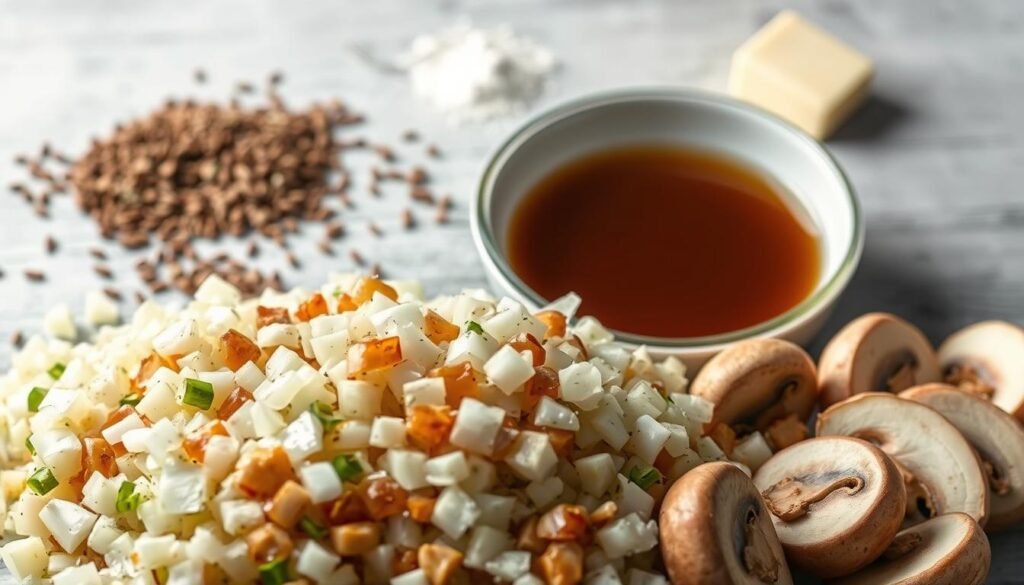
Choosing the right stock or broth and flour lets you make a brown gravy that’s delicious and fits your needs or taste.
Step-by-Step Instructions for Making Brown Gravy
Making brown gravy from scratch is easier than you think. I’m here to guide you through it. With a few simple ingredients and some straightforward steps, you can create a delicious gravy to complement your meals.
Preparing the Base
The foundation of a great brown gravy starts with a good base. You’ll need some form of stock or broth. You can use beef, chicken, or vegetable broth, depending on your preference and the meal you’re serving. If you’re using a store-bought broth, choose a low-sodium version to control the saltiness of your gravy. Homemade broth adds a depth of flavor that’s hard to beat.
To prepare the base, simply heat your chosen broth in a saucepan over medium heat. If you’re in a hurry, you can use hot broth straight from the carton or can. But heating it gently can help to bring out the flavors.
Thickening the Gravy
Thickening is a crucial step in making brown gravy. The most common method involves using a roux, which is a mixture of flour and fat. To make a roux, melt 2 tablespoons of butter or fat in a pan over medium heat, then whisk in 2 tablespoons of all-purpose flour. Cook this mixture for about 1-2 minutes, stirring constantly, until it turns a light brown color.
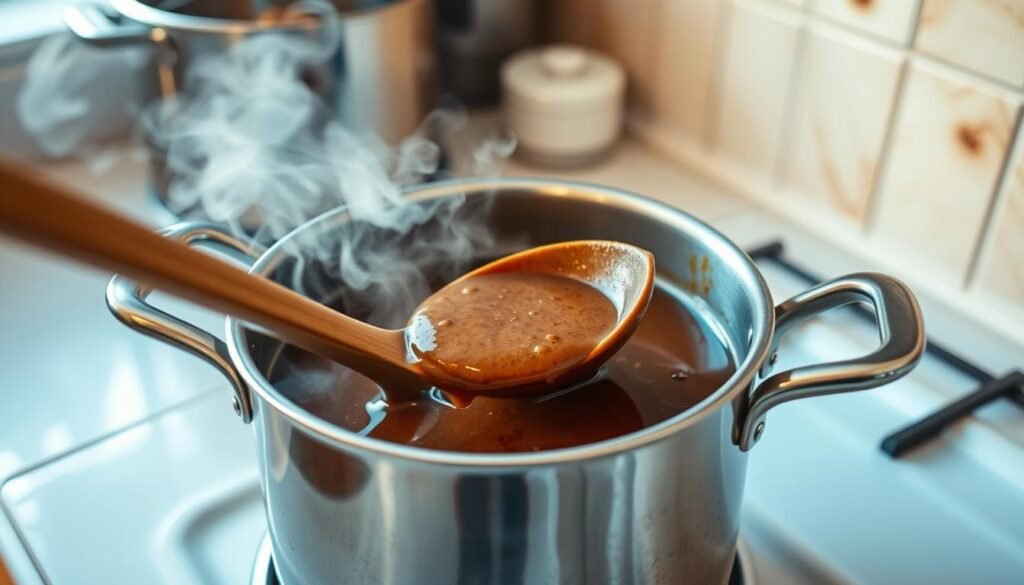
Gradually whisk the hot broth into the roux, continuing to stir to avoid lumps. Bring the mixture to a simmer and let it cook for a few minutes until it thickens to your liking.
Final Seasoning Tips
Once your gravy has thickened, it’s time to season. Start with a pinch of salt and a few grinds of black pepper. You can also add other seasonings to taste, such as dried herbs or a splash of Worcestershire sauce. Taste as you go, adjusting the seasoning until it complements your meal perfectly.
Remember, the key to a great gravy is in the balance of flavors. Don’t be afraid to experiment and adjust the seasoning to suit your taste.
Cooking Techniques: Stovetop vs. Oven
Cooking brown gravy can be done in two main ways: stovetop and oven. Each method has its own benefits. Your choice depends on what you like, the recipe, and what you want to achieve.
Advantages of Stovetop Cooking
I prefer making brown gravy on the stovetop. It lets me adjust and check the gravy easily. I can quickly add flour to thicken it or seasonings as I go.
Immediate Feedback: Stovetop cooking gives you instant feedback. You can see and taste the gravy’s consistency and flavor right away. This makes it easy to tweak it as needed.
When to Use the Oven
Oven cooking is great for recipes that need less attention. It’s perfect when you’re making a big meal and don’t want to use the stovetop.
Reduced Risk of Lumps: The oven helps avoid lumps in the gravy. The heat spreads out evenly. This method is good for beginners or those who find stovetop tricky.
| Method | Advantages | Best For |
|---|---|---|
| Stovetop | Quick adjustments, immediate feedback | Recipes requiring constant monitoring |
| Oven | Hands-off, reduced risk of lumps | Large meals, beginners |
In conclusion, both stovetop and oven cooking are useful for making brown gravy. Knowing the benefits of each helps you pick the right method for your needs.
Variations to Try: Elevate Your Gravy Game
With a few tweaks, you can turn basic brown gravy into a standout accompaniment for your meals. Try different ingredients to create unique flavor profiles. This will elevate your dining experience.
Mushroom Brown Gravy
To make a delicious mushroom brown gravy, start by sautéing sliced mushrooms in butter until they’re tender and fragrant. Then, add your brown gravy base and simmer until the flavors meld together. This variation adds an earthy, umami flavor that pairs well with roasted meats and mashed potatoes.
Onion Gravy for Extra Flavor
For an onion gravy, caramelize onions in a pan until they’re sweet and deep brown. Mix these caramelized onions into your brown gravy for an added layer of flavor. The sweetness of the onions complements grilled meats and roasted vegetables beautifully.
Here’s a comparison of the two variations:
| Feature | Mushroom Brown Gravy | Onion Gravy |
|---|---|---|
| Main Ingredient | Mushrooms | Onions |
| Preparation Method | Sauté mushrooms in butter | Caramelize onions |
| Flavor Profile | Earthy, umami | Sweet, savory |
| Best Paired With | Roasted meats, mashed potatoes | Grilled meats, roasted vegetables |
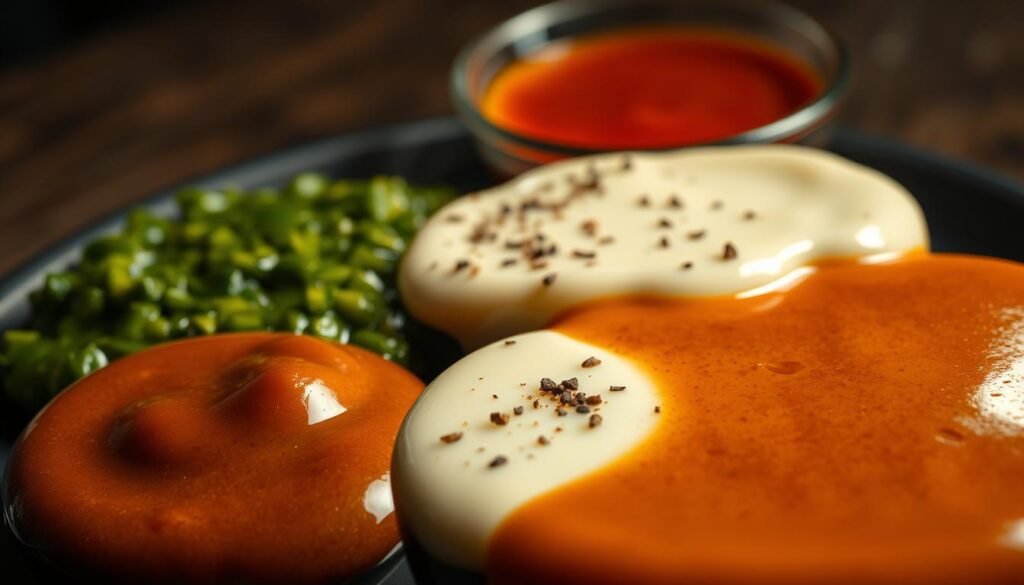
Experimenting with these gravy variations can add a new dimension to your meals. Whether you prefer the earthy taste of mushrooms or the sweetness of caramelized onions, there’s a variation to suit your taste.
Pairing Suggestions: What Goes Well with Brown Gravy
Brown gravy is great with many dishes, from classic comfort foods to new recipes. It adds depth and richness to your meals. Whether you’re cooking traditional dishes or trying something new, brown gravy is a great choice.
Classic Comfort Foods
Classic comfort foods are a big part of American cuisine. Brown gravy is a perfect match for many of these dishes. Here are some popular pairings:
- Mashed potatoes: A classic combo that’s unbeatable.
- Roasted meats: Brown gravy brings out the flavor of beef, pork, or chicken.
- Meatloaf: A comforting favorite that pairs well with savory gravy.
These pairings are sure to please. You can also try using brown gravy as a dip for snacks, like a taco dip recipe for a unique twist.
Alternative Pairings for Unique Meals
Brown gravy isn’t just for classic comfort foods. It’s also great for more innovative dishes. Try it with:
- Vegetarian dishes: Roasted veggies or vegetarian “meatloaf” get a boost from brown gravy.
- International cuisine: Use it as a sauce for beef or vegetable stir-fries.
- Breakfast items: Yes, brown gravy is good over breakfast foods like biscuits and eggs or hash browns for a savory start.
Exploring new pairings can help you find new favorites. Brown gravy is very versatile.
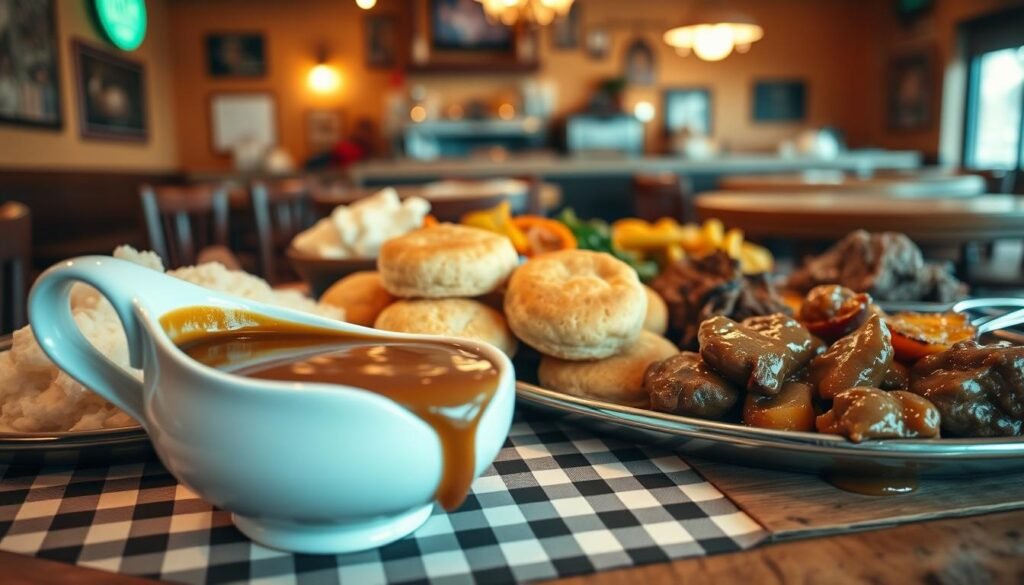
Troubleshooting Common Gravy Issues
Fixing gravy problems is key to making perfect homemade brown gravy. Even with great recipes, things can go wrong. But with these tips, you can fix your gravy and get it just right.
How to Fix a Runny Gravy
A runny gravy can be a bummer, just when you’re ready to eat. To fix it, add a bit more flour or cornstarch. Mix it with cold water or broth first to avoid lumps.
Another way is to reduce the gravy by simmering it longer. This will make it thicker and creamier. But don’t overdo it, or it’ll get too thick.
Dealing with Lumpy Gravy
Lumps in your gravy can be off-putting. To fix this, try straining the gravy through a fine-mesh sieve or cheesecloth. This works well but might thin it out a bit.
Or, use an immersion blender to smooth it out in the pot. If you don’t have one, blend it in a blender and then put it back in the pot.
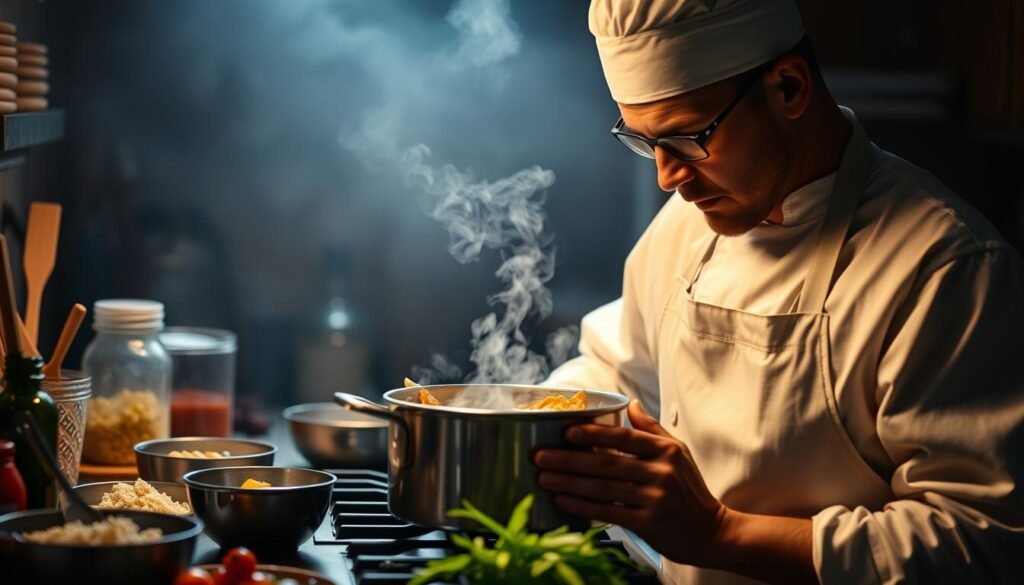
With these tips, you can tackle common gravy problems. Whether it’s too runny or lumpy, these solutions will help you get a smooth, tasty gravy for your meals.
Storing Leftover Gravy: Best Practices
Storing leftover gravy is simpler than you might think. I’m here to show you how. Whether it’s a big batch of homemade brown gravy or leftovers from a special meal, proper storage saves time and reduces waste.
Refrigeration Tips
To store leftover gravy in the fridge, cool it down fast to stop bacteria growth. Move the gravy to an airtight container and put it in the fridge within two hours of cooking. Always use a shallow container to cool it faster. Reheat it on the stovetop or in the microwave when you’re ready.
Before refrigerating, label the container with the date. Leftover gravy can stay in the fridge for 3-4 days. If you won’t use it in that time, freeze it.
Freezing Brown Gravy for Later Use
Freezing is a great way to keep your leftover gravy fresh longer. Pour cooled gravy into an airtight container or freezer-safe bag. Remove as much air as you can before sealing. This prevents freezer burn. You can also freeze it in ice cube trays for easy portions.
To use frozen gravy, thaw it in the fridge overnight or quickly by submerging the container in cold water. Reheat it gently, whisking constantly to avoid lumps. Frozen gravy stays good for 3-4 months.
By following these easy storage tips, you can enjoy your homemade brown gravy later. It makes meal prep easier and cuts down on waste. Whether you refrigerate or freeze, your gravy will stay delicious for your next meal.
Brown Gravy and Dietary Modifications
Gluten-free or vegan? No worries, you can still make delicious homemade brown gravy. Just a few simple swaps will make it tasty for everyone.
Creating brown gravy for different diets is simpler than you think. It’s all about knowing the right swaps for each diet.
Gluten-Free Options
Gluten-free folks can’t use regular flour in brown gravy. Instead, try gluten-free flour or cornstarch to thicken it. Make sure your gluten-free flour has xanthan gum for better texture.
| Gluten-Free Thickening Agent | Ratio | Notes |
|---|---|---|
| Cornstarch | 1:1 with flour | Mix with cold water before adding |
| Gluten-Free Flour Blend | 1:1 with flour | Ensure it contains xanthan gum |
| Arrowroot Powder | 1:1 with flour | Can make gravy slightly shiny |
Vegan Alternative Recipes
Vegans can enjoy rich brown gravy with a few tweaks. The main change is using plant-based broth instead of meat broth. Try vegetable or mushroom broth for extra flavor.
For more umami, add a teaspoon of miso paste or nutritional yeast. They not only taste great but are also good for you.
For a fun twist, pair your vegan brown gravy with a taco dip recipe. It’s a tasty and satisfying snack.
How to Make Gravy from Scratch Using Meat Drippings
Making gravy from scratch is easy and makes meals better. Using juices from roasted meats gives the gravy a rich flavor. This is something store-bought mixes can’t match.
Collecting Meat Drippings
To begin, collect the meat drippings from your roast. Pour off the juices from the roasting pan carefully. Use a fat separator to get rid of excess fat, keeping the flavorful drippings.
Enhancing Flavor
The secret to a great gravy is in the flavor. Using meat drippings as a base makes the gravy rich and savory. You can also add herbs or spices for a unique taste.
Techniques for making gravy work well in other recipes too. For example, in a taco dip recipe, flavorful drippings can enhance the dish.
By following these steps and using quality ingredients, you can make a delicious homemade gravy. Mastering this skill lets you create many flavors for any meal.

